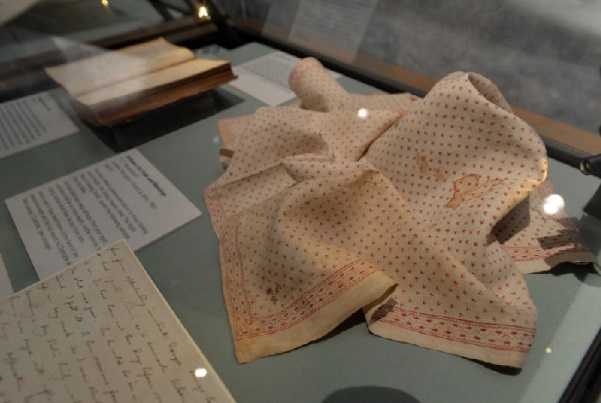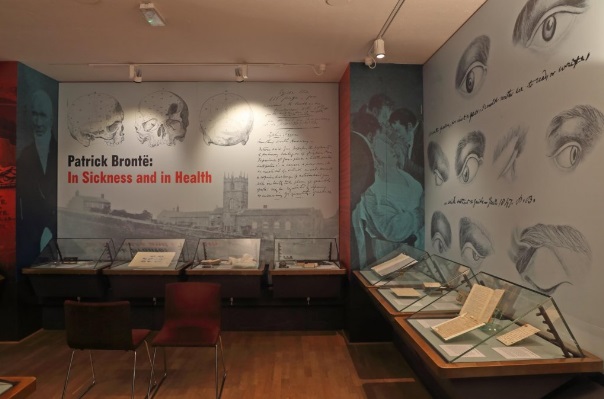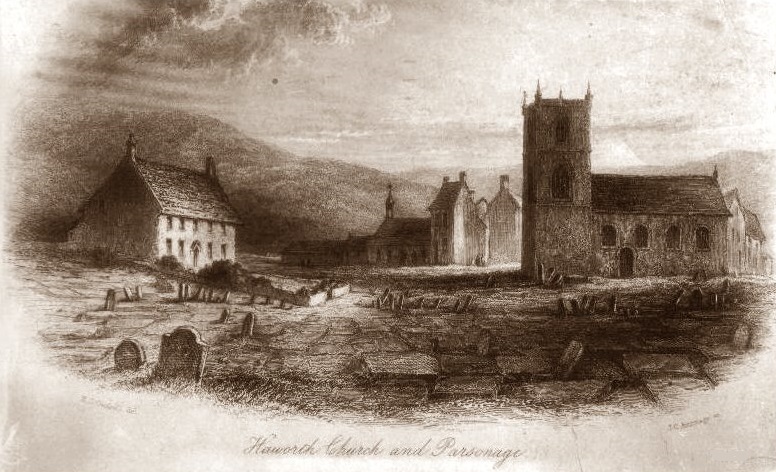This week I visited the ‘Patrick Brontë: In Sickness And In Health’ exhibition at the Brontë Parsonage Museum in Haworth. As always, it’s well worth a visit, and it was good to see lots of people in attendance even on a midweek day.
The section on Patrick is contained in the exhibition room at the side of the shop, and here you’ll find a fascinating range of items, including Anne Brontë‘s bloodstained handkerchief and Patrick’s own medical books, complete with his own notes and additions. In those days when healthcare was little understood and often little available to the ordinary families of villages like Haworth, the village priest was often expected to be able to dispense medical advice. This was a task that Patrick took very seriously, and of course it was largely thanks to his efforts that reservoirs were built near Haworth and sanitation was improved, saving thousands of lives in the years that followed.

It was a particularly fitting time to visit, because this week marked the anniversary of the death of the Reverend Patrick Brontë.
Patrick died in the mid afternoon of 7th June 1861, aged 84. He had served as parish priest of Haworth for over 41 years, and his venerable age was both a blessing and a curse. He had achieved a huge amount, rising from very humble beginnings to Cambridge University and then a life of service to the church, and he’d also published a novel and poetry collections. Of course, he also had to witness the death of his wife and all six of his children.
Being curate of Haworth wasn’t an easy task at these tumultuous times (just ask his predecessor Reverend Redhead who had to quit the post after his parishioners tried to bury him alive), but through his unwavering commitment and genuine goodness, Patrick won the village over. Perhaps the greatest mark of the respect that he was held in can be found in the fulsome report of his death and funeral contained in the Bradford Observer of Thursday, 13th June 1861. He was loved by his children, and by his parishioners, and without his guidance would we have any of the Brontë novels we love today? I leave you with the Bradford Observer’s report:

“The last link connecting the Brontë family with the living has snapt asunder. The father of Currer, Acton, and Ellis Bell died at the Parsonage of Haworth, on Friday last, at the age of 83. He went down to the grave in the ripeness of years, and as the last of his race, his gifted children having all died before their father. Mrs. Gaskell, in her “Life of Charlotte Brontë’,” has given a sketch of the life of Mr. Brontë, from which, and other sources, we give a few particulars, reserving for another opportunity some interesting particulars respecting the Brontë family, kindly to be supplied by an intimate friend of the deceased. The Rev. Patrick Brontë was born in the parish of Ahellerergh, County Down, Ireland, on the 17th March, 1777. His father was a farmer, and had a large family, remarkable for physical strength and personal beauty. Patrick Brontë gave early tokens of extraordinary quickness and intelligence. He had also his full share of ambition; and of his strong sense and forethought there is a proof in the fact that, knowing that his father could afford him no pecuniary aid, and that he must depend upon his own exertions, he opened a public school, at the early age of sixteen: and this mode of living he continued to follow for five or six years. He then became a tutor in the family of the Rev. Mr. Tighe, rector of Drumgooland parish. Thence he proceeded to St. John’s College, Cambridge, where he was entered in July 1802, being at the time five-and-twenty years of age. After nearly four years’ residence, he obtained his B.A. degree, and was ordained to a curacy in Essex; from Essex he removed about the beginning of this century to Hartshead cum Clifton, near Cleckheaton. Whilst incumbent of this place he married Miss Maria Branwell, a native of Penzance, who was reputed a woman of an excellent disposition and cultivated mind. At Hartshead two of his children, Maria and Elizabeth were born, after which Mr. Brontë removed to Thornton, near Bradford, where Charlotte, Patrick Branwell, Emily June, and Anne were born. On the 29th February, 1820, he removed to Haworth, where he remained until his death. He was ever on kind and friendly terms with each denominational body; but from individuals in the village the family stood aloof, unless some direct service was required from the first. He was, however, faithful in visiting the sick, and all who sent for him, and diligent in attendance at the schools. He was of a strong passionate nature, which, however, he compressed down with resolute stoicism. He was universally esteemed by the people among whom he lived, and his demise is deeply lamented.
The Rev. Mr. Nicholls, the husband of the late Charlotte Brontë, better known as Currer Bell, was with the deceased in his last hours. He did not speak after six o’clock on Friday morning, and died between two and three o’clock that afternoon. The vacant living is in the gift of the Rev. Dr. Barnet, Vicar of Bradford. Mr. Brontë was, like his more celebrated children, addicted to literary pursuits. At least four works of his were published, viz., “Cottage Poems,” printed by P. K. Holden, Halifax, 1811; “The Rural Minstrel,” published in 1813, same printer; “The Maid of Killarney, or Albion and Flora,” printed by T. Inkersley, Bradford, 1818; and ” The Cottage in a wood, or the Art of becoming Rich and Happy,” same printer as the last, published in 1818. His compositions have some characteristics in common with those of his children, and at times display deep observation and vigorous power of expression. It is said that, when correcting the proofs of a sermon published in 1824, in the office of Mr. Inkersley, Bradford, he was assisted in his labors by a little daughter about eight years old, probably Charlotte, who learned thus early to manage proofs.
Yesterday, the remains of the venerable man were consigned to the tomb. By the authority of the Secretary of State, the grave of Charlotte Brontë was again opened, and the coffin of the father was placed beside that of the daughter. The old town of Haworth was full of mourners. The shops were closed, and business was entirely suspended. The old graveyard was crowded with a sorrowful stricken concourse. The Rev. A. Nicholls was the chief mourner. The Rev, Dr. Barnet, vicar of Bradford, and the Rev. Dr. Cartman, vicar of Skipton, preceded the coffin, which was borne from the parsonage to the church, and thence to the grave, by six clergymen resident in the immediate district, and close friends of the deceased – namely, the Rev. Joseph Grant, incumbent of Oxenhope; the Rev. Joseph Mitchell, incumbent of Cullingworth; the Rev. J. Taylor incumbent of Newsome; the Rev. William Fawcett, incumbent of Morton; the Rev. John Smith, incumbent of Oakworth; and the Rev. W. G. Mayne, incumbent of St. John’s, Keighley. The sublime and touching burial service of the Church of England was read, amidst the audible sobs of the surrounding crowd, by the Vicar of Bradford. The Rev. A. Nicholls appeared to be deeply affected, and was supported from the grave to the parsonage by the Vicar of Skipton. The day of mourning and woe will be long remembered in Haworth and the surrounding district.”
